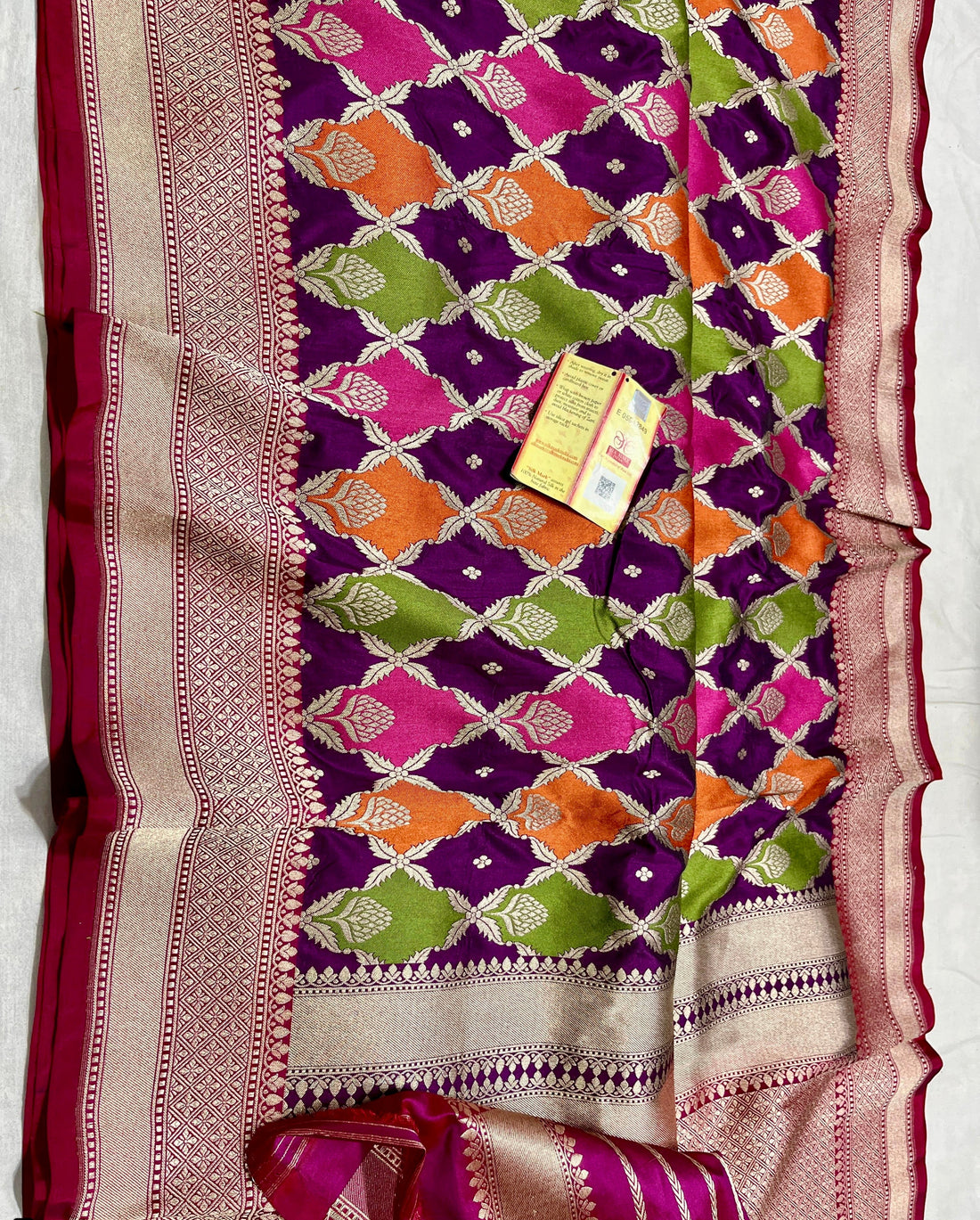
The Rangkaat Weave: A Heritage of Color in Banarasi Sarees
Share
Introduction – The Magic of Rangkaat
Banarasi sarees are known worldwide for their luxurious silk and intricate zari patterns. Among the many weaving styles, Rangkaat stands out as one of the most colorful and complex. Derived from the Hindi word “rang” (color), Rangkaat weaving involves combining multiple colored silk threads diagonally within the body of the saree, often highlighted with zari work. The result is a vibrant, geometric play of hues that looks like a woven patchwork of motifs—yet every element is created on the loom itself, not stitched or printed.
In today’s world of mass-produced textiles, a Banarasi Rangkaat Katan Silk Saree is a rare treasure that speaks of heritage, artistry, and cultural pride.
The Weaving Process of Rangkaat
Creating a Rangkaat saree is a labor-intensive process that requires immense skill:
-
Design Mapping: The weaver first prepares a detailed graph design with diagonal blocks of motifs and colors.
-
Silk Preparation: Pure katan silk yarn is dyed in vibrant shades like magenta, green, orange, purple, and pink.
-
Loom Setup: Multiple shuttles are used simultaneously to weave different colors into the body.
-
Zari Highlighting: Real tested zari is interwoven to give shimmer to the motifs and outline the blocks.
-
Time Investment: A single saree can take several weeks, depending on complexity.
Unlike prints, where color sits on the surface, here the design is woven into the structure of silk itself, making it long-lasting and unique.
Historical & Cultural Significance
The Rangkaat weave is believed to have originated in Banaras centuries ago, inspired by temple architecture and Mughal geometric patterns. Its multicolor play was designed to reflect festivity and abundance. Traditionally, Rangkaat sarees were reserved for weddings and royal occasions, symbolizing prosperity and joy.
Today, they are still favored for bridal trousseaux, temple rituals, and grand cultural ceremonies, especially because they bring together rich zari with vibrant colors.
What Makes a Rangkaat Saree Unique?
-
Multicolor Diagonal Layout: Unlike typical Banarasi sarees with single-tone bodies, Rangkaat uses multiple hues.
-
Handwoven Authenticity: Every motif is woven, not stitched or appliquéd.
-
Silk Mark Certified: Pure silk authenticity is guaranteed.
-
Zari Borders & Pallu: Enhances the richness, making it suitable for grand occasions.
-
Rarity: Compared to floral jaal or butidar Banarasis, Rangkaat is less commonly woven, making it highly desirable for collectors.
When to Wear a Rangkaat Saree
-
Bridal Wear: Perfect for wedding rituals, especially for brides who want vibrant tradition.
-
Festivals: Diwali, Holi, Navratri, and other cultural celebrations.
-
Cultural Events: Dance recitals, temple functions, heritage gatherings.
-
Heirloom Collection: Families often preserve Rangkaat sarees as timeless heirlooms.
Pair them with antique gold jewellery or kundan sets, and style with contrast blouses to highlight the multicolor base.
Caring for a Rangkaat Banarasi Saree
-
Always store in muslin cloth and avoid plastic covers.
-
Refold every 2–3 months to prevent zari creases.
-
Keep away from moisture and direct sunlight.
-
Avoid hanging heavy silk sarees for long durations.
Why Rangkaat Banarasi Sarees are an Investment
Unlike fast-fashion textiles, handloom Banarasi sarees increase in value over time due to their rarity and heritage. A Rangkaat saree is not just clothing—it is a piece of cultural history woven into silk. With its Silk Mark certification, it assures you of purity, making it both an heirloom and a collector’s item.
Conclusion
The Banarasi Rangkaat Katan Silk Saree represents the perfect harmony of color, zari, and tradition. For brides and saree enthusiasts alike, it is an opportunity to own a weave that is rare, vibrant, and deeply rooted in Indian heritage.
👉 Explore the Banarasi Rangkaat Silk Saree here.
